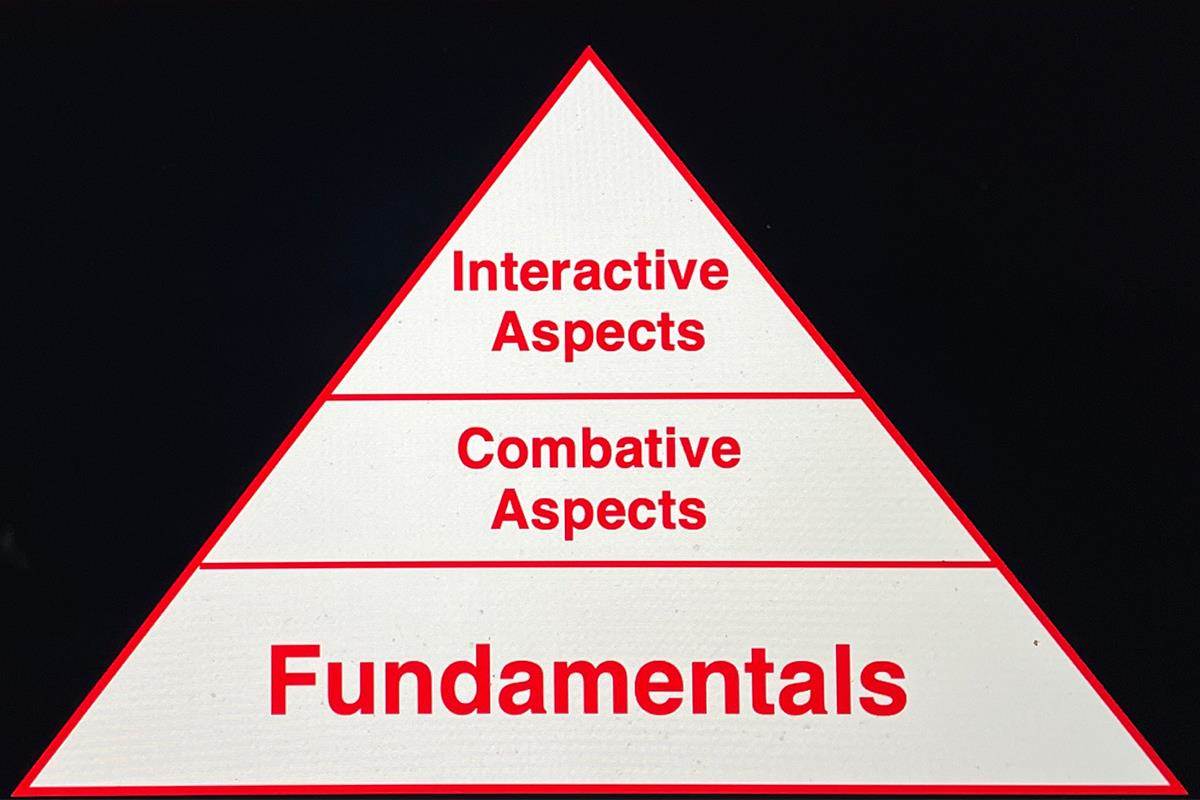Hierarchy of Combative Firearms Training
BY PGFSafely handling a firearm and improving marksmanship at the range is just the beginning for armed citizens and professionals. Follow this Hierarchy of Combative Firearm Training to understand what skills are necessary, and in what order they should be learned.
According to my Webster’s Dictionary, training is defined as “to instruct so as to make proficient.” Instruct means “to teach, educate or inform,” while proficient means “highly competent, skilled.” Thus, combative handgun training, in my mind can be defined as follows: Teaching a person to be highly competent and skilled in the use of a handgun for personal defense. How much skill do you need to proficiently take care yourself? Who knows? For me, it’s as much skill as I can develop because it will be my life on the line, and my life is really important!
The three levels of combative pistolcraft. (from Dave Spaulding, found at the link)
Base Level: Essentials
The Essentials level provides the foundation for everything else to build upon. Compare it to placing your hands at 10 and 2 on the steering wheel when learning to drive. The fundamentals include safe handling, grip, body position (aka stance), sight alignment, sight picture, loading and unloading and, most importantly, trigger control. You know, all of the things that keep the gun running.
The grip should use both hands and cover as much of the grip as possible. The grip is the human contact with the firearm, place as much skin on the gun as you can. Any area of the grip left open will provide an avenue for recoil to carry the gun off target, making quick, follow-up shots more difficult. And follow-up shots may be needed to end the fight.
I’ve quit using the term stance as it relates to shooting a handgun because it really doesn’t matter where your feet are situated. As a matter of fact, it’s quite likely they will not be where you want them when you need to shoot. What is more important is keeping your body in a position that allows you to deliver multiple shots in multiple directions without being thrown off balance. In general, this means you must keep your shoulders over your toes and your knees unlocked.
Clearing a stoppage or malfunction is a requirement for any piece of machinery, but in a gunfight it is a life-saving skill. For semiauto pistols, you must be able to clear any malfunctions quickly and easily, which is not as hard as it sounds. Someone just has to show you how to do it. Revolvers are a whole different matter. A quality revolver runs under very extreme conditions, but when it malfunctions it usually requires a trip to the gunsmith. Some would say this is an advantage of the revolver over the pistol — I will leave that up to you.
While many wish to debate using sights versus point shooting, I’ve found neither is very important if the shooter can’t control the trigger. Without trigger control, the muzzle won’t stay in alignment with the target, and the shot will miss regardless of the system used. Only hits count, so while I admit I’m an advocate of sighted fire, I’m an even greater advocate of trigger control. Without it, everything else is a doomed to failure.
All of the skills taught and practiced at the Essentials level are required to keep the gun running in a fight. That is why I say they are essential. While some may consider one skill more important than another, ask yourself, which skills will be needed to win your gun fight? That’s right, you don’t know. So, having a mastery of all will be required to rapidly adapt to the situation faced.
Ultimately, the most essential of essentials is a combative mind, but you won’t find that listed among the classic fundamentals of shooting or taught in basic marksmanship classes.
Continues at the link with mid-level and upper-level interactive combatives.






On June 26, 2023 at 11:29 pm, Dan said:
This applies to many skills. Not just firearms.
On June 27, 2023 at 3:50 pm, George said:
deep thought here: stop moving the gun when you pull the trigger.
Think that through. More to it than you think. It is more than “jerking the trigger”. Rob Leatham demonstrated that one can jerk the trigger if the grip is tight enough not to move the gun.
Most right hand shooters that shoot low and left (conversely for left handers) do so because they clench the grip when they pull the trigger. You can discuss the reasons for this, but it results in moving the gun as they pull the trigger.
YMMV